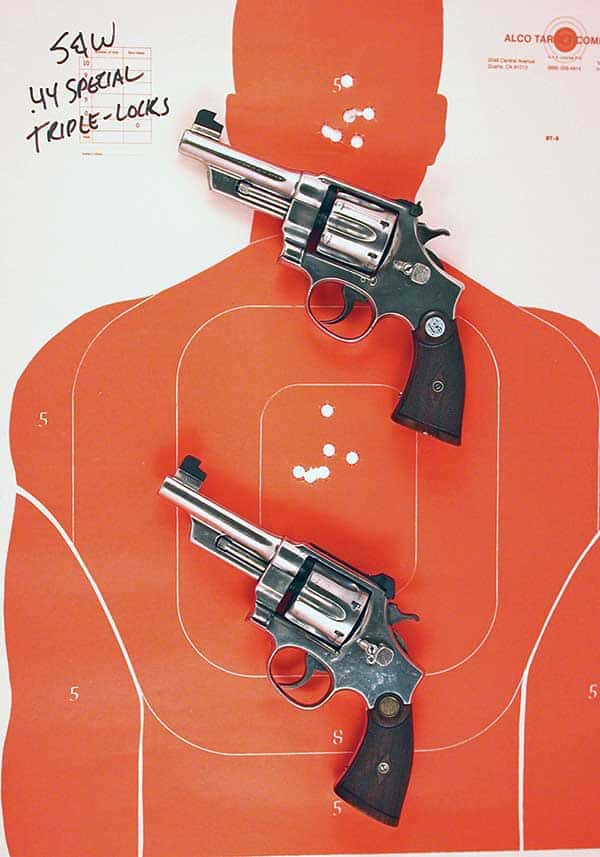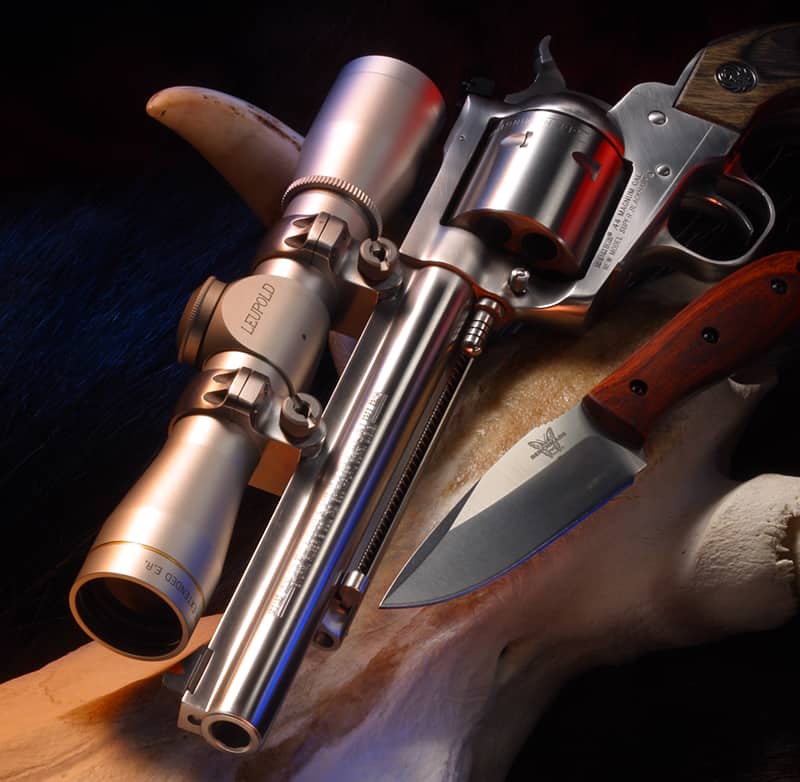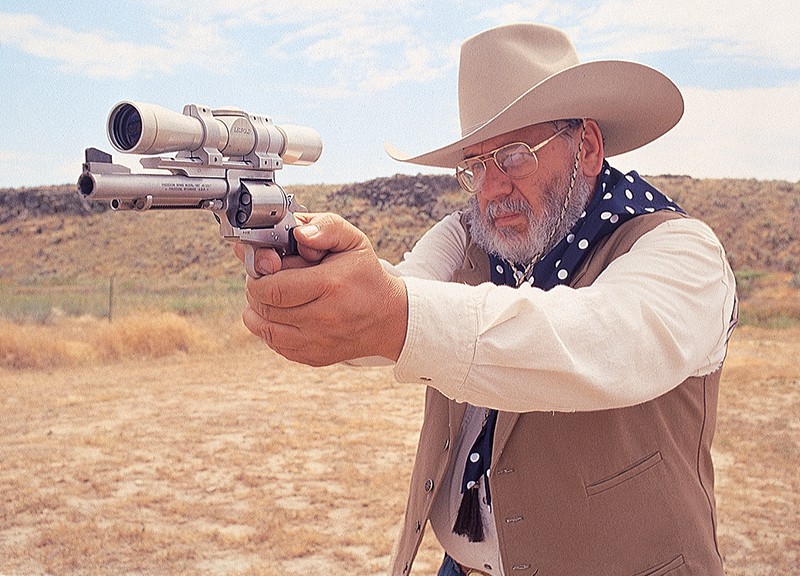What Were They Thinking?
Apparently, Nothing At All
Regular readers know of my affection for the old Smith & Wesson Classic N-Frames, the .44 Special Hand Ejectors, the .38/44 Heavy Duty and Outdoorsman, the .44 Magnum and, most assuredly, the .357 Magnum. The latter arrived out of experiments in the early 1930s by Phil Sharpe and Col. Doug Wesson with exceptionally heavy .38 Special loads in the .38/44 Outdoorsman and Heavy Duty. These guns were built on the large-frame .44 Special Model 1926 so they were very strong sixguns.
In 1935 when the new sixgun arrived from S&W, it was simply called the .357 Magnum. The earliest guns were virtually hand-built custom revolvers and were known as Registered Magnums with a special serial number stamped inside the ejector rod housing. A special registration certificate also came with these early .357 Magnums. Even in the midst of a depression the demand was so high S&W dropped the special registration and just offered a standard model. It was however a superb standard model to be sure.
P And R
The Smith & Wesson .357 Magnum was finished in the old Bright Blue with nickel being offered as an option, the action was the smooth double-action S&W has always been known for, the topstrap and the full-length barrel rib were both finely checkered, and shooters had a choice of barrel lengths and sights. All of these sixguns were also what has come to be known as “P and R,” standing for Pinned and Recessed. These terms came from the fact the barrel was screwed in place and then fitted with a pin through the frame side-to-side and into a channel in the top of the barrel. The cartridge heads were enclosed, or recessed in the cylinder. Production was, of course, stopped during WWII and resumed very slowly in the late 1940s and early 1950s.
In 1957, the .357 Magnum became the Model 27, and then in succession Model 27-1, 27-2, etc. Along the way the pinned barrel and recessed cylinder were dropped to cut production costs. I have an 8-3/8″ Model 27-3 and a pair of 5″ Model 27-5s, and while both are excellent shooting sixguns, they are neither pinned, nor recessed. Now before me on the gun show table was a beautiful example of a Smith & Wesson .357 Magnum. I can rarely resist one of these classic sixguns especially when the price is right. This one was a nickel-plated Model 27-2 with a 5″ barrel. I am especially drawn to nickel-plated examples of these old N-Frames.
I looked it over (well, at least I thought I did): rifling was sharp and clean, the cylinder locked up tight, the action was definitely S&W, so needless to say I bought it. When I got home I found a pair of BluMagnum Skeeter Skelton stocks crafted of curly maple and they not only fit perfectly, they really mated up well aesthetically with the nickel plating. It didn’t take many shots for me to realize something was wrong. After two cylinders full the barrel had loosened and could be wiggled back and forth.
The Shocking News
Taking it to my gunsmiths at Buckhorn Gun I soon had the sad news. The pin was driven out, the barrel removed, and very easily so simply because there was very little thread left on the frame. Someone had really done something unbelievable. And that something was trying to remove the barrel without popping the barrel-retaining pin out first. What were they thinking? Somehow they managed to bend the retaining pin, twist the barrel, and wipe out most of the frame threads in the process. There certainly was not enough thread left to re-thread it in any way; so what to do? The best choice would be to find a stripped-down frame somewhere, however that was not likely to happen. Another choice was to simply part it out and help fill the parts box with a lot of S&W parts. Or, do what we did.
The barrel was epoxied back into place and a new pin installed. So far, it has held. I do not shoot full-house .357 Magnum loads in it, but rather standard .38 Specials and .38/44 loads. It is such a beautiful looking and handling sixgun it probably would not be too hard to pass it on to some poor unsuspecting soul, however I cannot function that way. The buck definitely stops here and if it comes a time when the barrel will not hold I will definitely part it out. However, one thing is sure and that is every time I shoot it I can’t help thinking what in the world was someone thinking when they did this? You don’t have to be a gunsmith to see the barrel retaining pin and understand its function.
In the February 2008 “Campfire Tales,” I told the beginning of a sad story of a pair of Smith & Wesson Triple-Lock .44 Specials. Both of these sixguns were made before WWI and one was even the very rare Target Model. Both had felt the wrath of the gun butcher. Barrels were shortened to 4″, front sights were poorly reset, they were both heavily buffed and then nickel-plated. One was still a Target Model with the original rear sight while the other one had a channel cut through the top strap for the installation of an adjustable Smith & Wesson sight, which never materialized. At the time of that previous Campfire Tales I had left one of these with a gunsmith to see if he could build a full length rib incorporating adjustable sights for one of these guns. He studied it for a while and then sent it back to me untouched. The amazing thing was both guns shot very well; after all they were Triple-Locks.
I turned them over to my gunsmiths, Mike Rainey and Tom Cripe at Buckhorn along with a modern Smith & Wesson rear sight assembly, and a D&L Heavy Duty Rear Sight Assembly from Dave Lauck. The latter sight is made to replace those found on any modern Smith & Wesson revolver which has the topstrap drilled and tapped with three factory screw holes under the rear sight. Once the rear sight is removed, the D&L sight replaces it and attaches with three provided screws. The integral rear sight blade is dehorned, and provides high visibility with its large square notch. There are absolutely no sharp edges to cut hands or clothing.
The two sights were fitted to the botched Triple-Locks and the front sights were milled off down to the bases and both were slotted to receive black post front sights which were then pinned in place. The only thing left for me to do is to settle on one standard load and file down the front sights to the proper height. These are definitely not pristine collectors items or examples of great Triple-Locks, but at least they are now in shooting shape and presentable in mixed company.
I saved the best (actually the worst) for last. In 1950 S&W revamped their lineup of .44 Hand Ejectors and the result was the 1950 Target Model .44 Special complete with a new short action and excellent adjustable sights. The companion piece was the fixed-sighted .44 Military Model. The latter is very rare and demands collector prices normally. A few months ago on one of the websites I frequent the question was asked about converting a .44 Special to .45 Colt. I let him know in no uncertain terms this was not an acceptable choice and especially so when I found out what it was. It was the rare .44 Military Model of 1950.
It was another example of, “What Were They Thinking?” In excellent original condition this 4″ .44 Special would be worth $2,000 or more; as it was I bought it for $500. This one was definitely not original condition as someone had decided to make it into a would-be gunfighter’s sixgun. The hammer spur was ground off, and both the original stocks and the square butt grip frame were roundbutted. Now all of these modifications are acceptable when well done, hopefully not on a rare sixgun, however it looked like somebody used a horseshoe file to perform the work. There were deep gouges in the grips and the modified grip frame had never been re-blued. I turned to my friend Butch Glenn who found a replacement hammer in his parts box, modified a pair of grips I happened to have, smoothed off the grip frame, and cold-blued it. It now looks presentable and also shoots quite well.
I have no problem with modifying sixguns to fit me personally. I have had many .357 Old Model Blackhawks converted to other calibers, and I even had a Colt New Service made into a Fitz Special. I would just ask that everyone think carefully about what they are doing. Is the sixgun so rare it should be kept original? If this is deemed not to be so, the work performed should at least be quality. Please don’t wind up with another sixgun that makes a dedicated sixgunner ask, “What Were They Thinking!”
D&L Sports
P.O. Box 4843, Chino Valley, AZ 86323
(928) 636-1726
www.dlsports.com
Tedd Adamovich Blu Magnum
2605 E. Willamette Ave.
Colorado Springs, CO 80909
(719) 632-2780
www.blu-magnum.com








